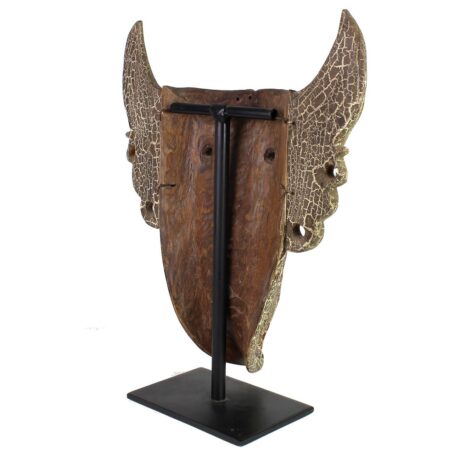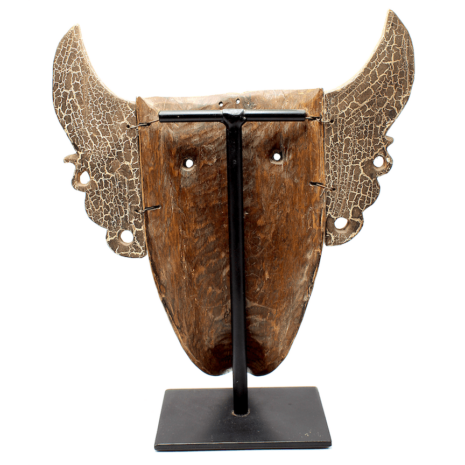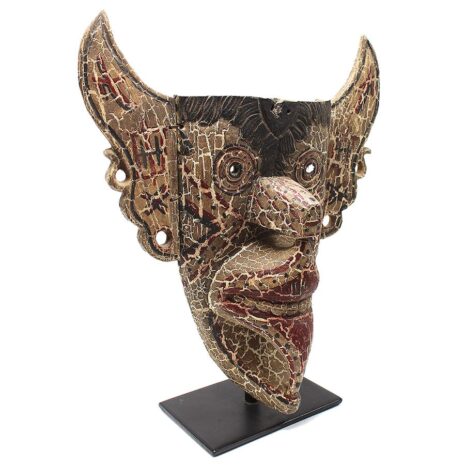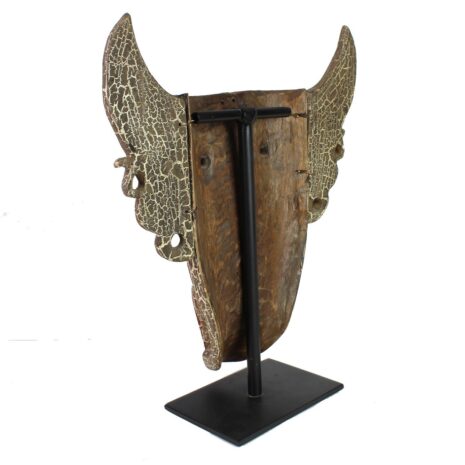Vintage Dayak Ancestor Mask (Hudoq), Kalimantan (Indonesian Borneo) (1200)
$485.00
H: W: D: Ht: 14.75″ W:12.125″ | FREE SHIPPING WITHIN CONTINENTAL U.S.
Description
Dyak tribal masks known as hudoq are made in many variations and styles depending on the group crafting them. Named after the agricultural festival celebrated in Kalimantan, hudoq means harmful crop pests believed to be removed from fields during fertility rituals to protect rice fields and dispel malevolent spirits, pests and harmful entities. This vintage mask is authentic and traditional but less elaborate than antique hudoq that are more decorative with bright colors. Like many hudoq, it has separately carved wing-like ears tied to the central piece with rattan that is now replaced. The exposed recessed gnashing teeth are traditional. Although antique pieces have vibrant colors, fangs and dangling attachments the colors here are muted and subtle. The carving and decorative painting are finely executed and more restrained. The long triangular nose, curved slit eyes, rectangular recessed mouth with clenched teeth, undulating snake-like elements on the wings and the fine painted decorations on the winged ears and top of the head are outstanding. This mask was personally collected in the mid 1970s in Bali. There are many reproductions and masks referred to as antiqu baru meaning “new antique” but authentic vintage masks like this are now scarce. This piece is in good condition with no restoration or repairs except for the replaced rattan.
Masks that are worn over the face be they large or small are known as hudoq, and there is a large variation of styles. They usually have large flat wing-like ears carved separately and attached to the mask with rattan, which usually dries cracks and becomes detached and accounts for old masks with the ears attached to the mask with newer string. Hudoq masks are not restricted to those worn on the face, as they are affixed to walls, doors, house supports, shields, burial poles and elsewhere. They are created in beadwork and attached to baby carriers, jackets and other clothing. They are also made from cut cloth and stitched into ceremonial skirts. Their purpose is to be an obstacle for and prevent malicious spirits from entering sacred communal spaces and challenge everything the mask is meant to protect. Masks are sentinels that secure the safety of the village: they guard family members behind longhouse doors, protect a baby asleep in the carrier on its mother’s back or defend the souls of the dead whose bones are placed in ceramic jars or placed on burial poles. Hudoq attract gods and sacred spirits from their heavenly home to assure fertility and banish anything polluting the rice crop or harming the village or its members. They may have deeply set round eyes, hanging earrings, decorative feathers, bulging or angular noses, drooping brows, exposed or fanged teeth and be painted in bright polychrome. They may also be simple or lavish images of a god, spirit, ancestor or animal caricature made to frighten, amuse or entertain.
This vintage piece is in excellent condition with no restoration or repairs except for the replaced binding at the winged ears and was personally collected in the 1970s in Bali.
Click here for the blog Indonesian Dance Masks (Topeng): Spiritually Connecting the Community
Additional information
| Place of Origin | Indonesia |
|---|---|
| Period | Vintage (1920-1980) |
| Date | 1970's |
| Materials and Technique | Wood |
| Dimensions (inches) | Ht: 14.75" W:12.125" D: 4.375” |
| Dimensions (metric) | Ht: 37.46cm W: 30.79cm D: 11.11cm |
| Weight | 5lbs 9oz |
| Condition | Excellent, fine patina demonstrating age and use |
| Item Number | 1200TCK |
| Shipping Box Size | Oversized. Call 213-568-3030 or email [email protected] for shipping. |










